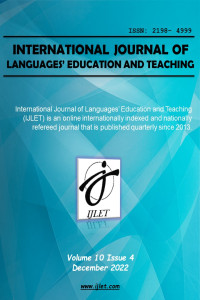Öz
On the basis of the markedness concept focusing on the use of language structures according to expectation- unexpectation
levels, the high frequency of language structure use is related to the expectation of that structure, which is marked. If the
emergence of a new structure is unexpected, it means that the structure is unmarked. The preference of the unmarked forms
instead of marked forms in languages is examined within the framework of markedness shift. In this study, the phenomenon
of markedness shift in the lexical plane of Turkish was carried out on quantitative real language data by examining whether
there are new marked forms that tend to be preferred instead of marked form ‘very’. In the analysis made in line with the
data obtained from TUDv3.0 using corpus-based method, it is based on the linguistic data in which the 10 adjectives with the
highest frequency in Turkish are pre-coded with the linguistic units ‘terrific’, ‘amazing’, ‘fantastic’, ‘unbelievable’,
‘extraodinary’, ‘magnificent’ and ‘excellent’ and these data were measured and compared. In the debate of ‘very’ adjective in
Turkish which encodes the meanings/functions of quantity, value, power, degree, excess vrs. “the other forms” it was found
out that determining a possible marked form is only possible by considering the possible marked form+adjective sequence,
as it was ascertained that linguistic structures with low level of expectancy differ in their preference tendencies according to
the adjectives coded after them, and the possible conditions of unmarkedness process within the framework of cognitive
change due to overuse is discussed. Accordingly, although the adjective ‘very’ seems to have begun to enter the process of
markedness shift, it was detected that the relevant adjective doesn’t completely leave its position to other marked forms since
this is related both the fact that the possible forms cannot reach the level of corresponding the concept/(s) to which the ‘very’
refers and the condition of leaving it's position depends on the adjective it describes.
Anahtar Kelimeler
Markedness marked form markedness shift sequence quantitiy adverb
Kaynakça
- Aksan vd. (2017). A Frequency Dictionary of Turkish Core Vocabulary for Learners. New York: Routledge.
- Biber, D. (2009). A Corpus-Driven Approach to Formulaic Language in English: Multi-word Patterns in Speech and Writing. International Journal of Corpus Linguistics, C/S. 14: 275-311.
- Dik, S. C. (1989). The Theory of Functional Grammar (Part I: The Structure of the Clause). Dotrech: Foris.
- Sebzecioğlu, T. (2008). Türkçede Edilgenlik. Yayımlanmamış Doktora Tezi, Dokuz Eylül Üniversitesi, İzmir.
- Sebzecioğlu, T. (2021). Dilbilim Kavramlarıyla Türkçe Dilbilgisi (Genişletilmiş İkinci Baskı). İstanbul: Kesit Yayınları.
- Sebzecioğlu, T. ve Oktar, L. (2010). Türkçede Edilgenliğin Belirtililik Kayması Açısından Bazı Görünümleri. Dilbilim Araştırmaları Dergisi, C/S. 0(2):19-43.
Öz
Dil yapılarının beklenirlik-beklenmezlik düzeylerine göre kullanılmasını odağına alan belirtililik kavramı temelinde, bir dil yapısının yüksek kullanılma sıklığı o yapının beklenirliği yani belirtili olmasıyla ilişkiliyken, yeni bir yapının ortaya çıkması beklenmezliğine yani belirtisiz olmasına gönderimde bulunmaktadır. Dillerde belirtili biçimlerin yerine belirtisiz biçimin yeğlenmesi de belirtililik kayması olgusu çerçevesinde incelenmektedir. Bu çalışmada Türkçenin sözcüksel düzleminde belirtililik kayması olgusu, belirtisizleşme sürecinde olduğu savunulan ‘çok’ belirtili belirtecinin yerine yeğlenme eğilimi gösteren yeni belirtili biçim(ler)in olup olmadığını niceliksel gerçek dil verileri üzerinden saptamak amacıyla gerçekleştirilmiştir. Derlem temelli yöntemle TUDv3.0’dan elde edilen veriler doğrultusunda yapılan incelemede Türkçede sıklığı en yüksek ilk 10 sıfatın ‘çok’ belirtecinin dilbilgisel konumuna koşut konumundaki ‘müthiş’, ‘dehşet’, ‘harika’, ‘inanılmaz’, ‘fevkalade’, ‘muhteşem’ ve ‘mükemmel’ dilsel birimleriyle kodlandıkları dil verileri temel alınmış, bu veriler ölçümlenerek karşılaştırılmıştır. Türkçede, nicelik, değer, güç, derece, aşırılık anlamlarını/işlevlerini kodlayan ‘çok belirteci’ krş. ‘diğer biçimler’ tartışmasında olası belirtili bir biçimin belirlenmesinin ancak Olası Belirtili Biçim + Sıfat dizilimin gözetilmesiyle mümkün olduğu; çünkü beklenirlik düzeyi düşük olan dilsel yapıların, kendilerinden sonra kodlanan sıfatların ne olduğuna göre yeğlenme eğilimlerinde farklılık gösterdiği bulgulanmış, bilişsel olarak yıpranmayla açıklanabilecek bir belirtisizleşme sürecinden söz edebilmenin olası koşulları tartışılmıştır. Buna göre her ne kadar ‘çok’ belirteci belirtililik kayması sürecine girmeye başlamış gibi görünse de ilgili belirtecin yerini tamamen diğer olası belirtili biçimlere bırakmadığı, bunun da hem olası biçimlerin ‘çok’ belirtecinin gönderimde bulunduğu kavram/(ları) karşılama düzeyine erişememesiyle hem de ‘çok’ belirtecinin yerini bırakma koşulunun nitelediği sıfata bağımlı olmasıyla ilişkili olduğu sonucuna ulaşılmıştır.
Anahtar Kelimeler
Belirtililik belirtili biçim belirtililik kayması dizilim miktar belirteci
Kaynakça
- Aksan vd. (2017). A Frequency Dictionary of Turkish Core Vocabulary for Learners. New York: Routledge.
- Biber, D. (2009). A Corpus-Driven Approach to Formulaic Language in English: Multi-word Patterns in Speech and Writing. International Journal of Corpus Linguistics, C/S. 14: 275-311.
- Dik, S. C. (1989). The Theory of Functional Grammar (Part I: The Structure of the Clause). Dotrech: Foris.
- Sebzecioğlu, T. (2008). Türkçede Edilgenlik. Yayımlanmamış Doktora Tezi, Dokuz Eylül Üniversitesi, İzmir.
- Sebzecioğlu, T. (2021). Dilbilim Kavramlarıyla Türkçe Dilbilgisi (Genişletilmiş İkinci Baskı). İstanbul: Kesit Yayınları.
- Sebzecioğlu, T. ve Oktar, L. (2010). Türkçede Edilgenliğin Belirtililik Kayması Açısından Bazı Görünümleri. Dilbilim Araştırmaları Dergisi, C/S. 0(2):19-43.
Ayrıntılar
| Birincil Dil | Türkçe |
|---|---|
| Konular | Dilbilim (Diğer) |
| Bölüm | Araştırma Makalesi |
| Yazarlar | |
| Yayımlanma Tarihi | 30 Aralık 2022 |
| Yayımlandığı Sayı | Yıl 2022 Cilt: 10 Sayı: 4 |


